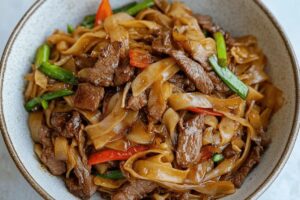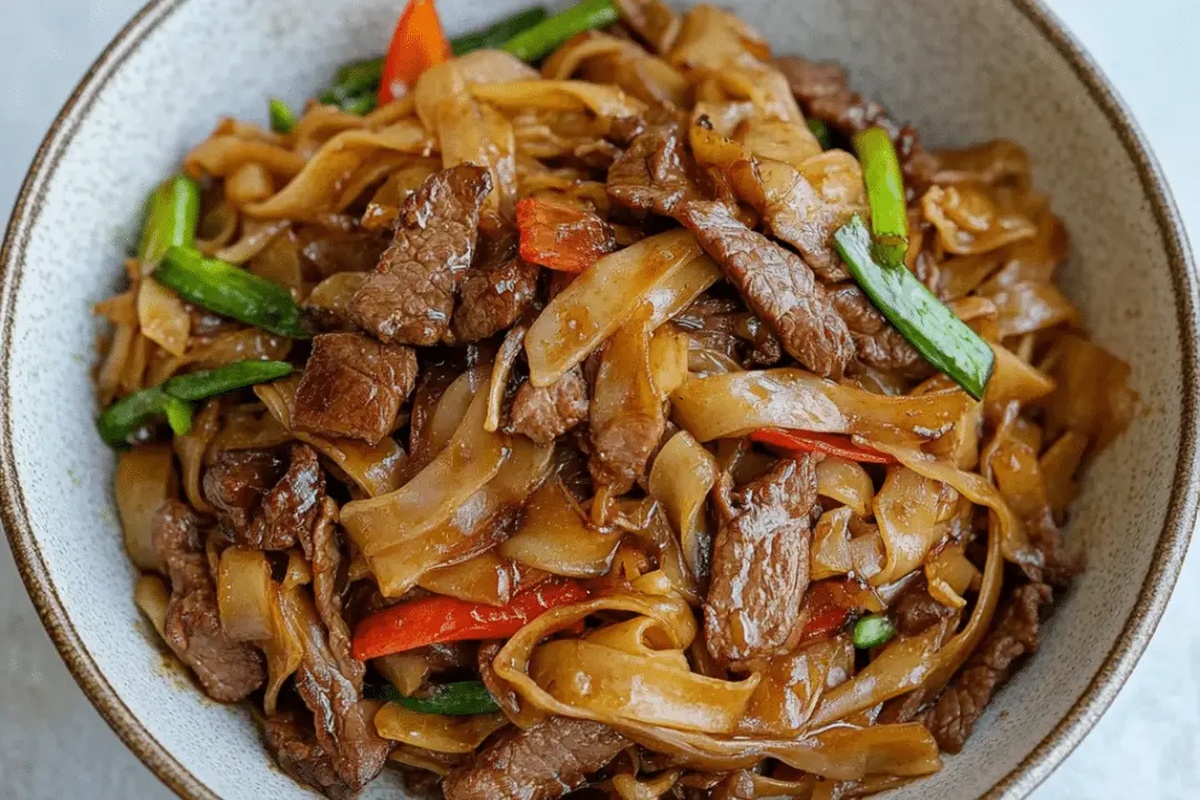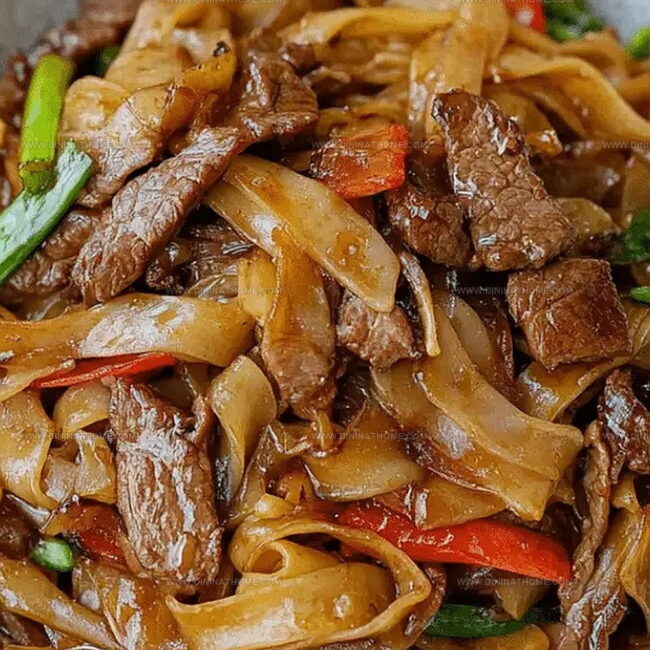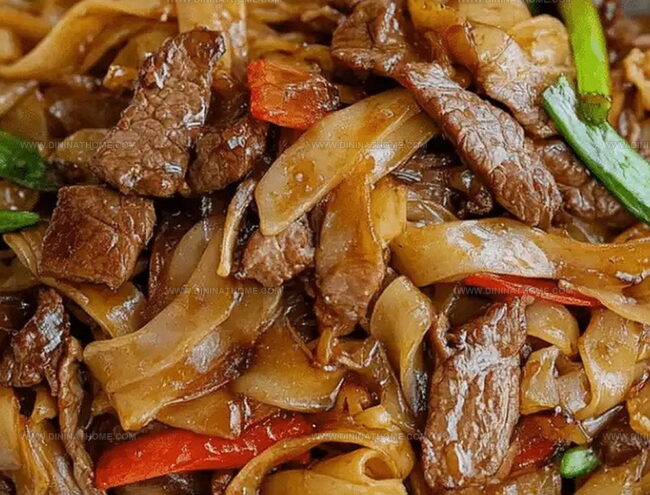Easy Thai-Style Stir-Fried Beef with Flat Rice Noodles Recipe
Culinary magic happens when you master this delectable stir-fried beef with flat rice noodles.
Savory aromas will drift through your kitchen, tempting every sense.
Tender strips of beef dance alongside silky noodles in a symphony of flavors.
Wok-seared ingredients create an irresistible blend of textures that sing with authentic charm.
Each bite promises a journey through traditional asian street food techniques.
Quick preparation meets intense satisfaction in this knockout dish that impresses without complicated steps.
Grab your chopsticks and let the adventure begin!
Stir-Fried Beef Noodles With Big Flavor Fast
Beef Stir Fry with Noodles – What You’ll Use
Main Proteins:Marinades and Seasonings:Noodles and Vegetables:Cooking Sauces:Beef with Flat Noodles Stir-Fry Method
Step 1: Marinate the Beef
Prepare a flavorful marinade for the beef by combining:Massage the ingredients into the beef slices and let them soak up the flavors for at least 30 minutes.
Step 2: Prep the Noodles
Cook the flat rice noodles following the package instructions.
Once done, drain thoroughly and set aside, ensuring they don’t stick together.
Step 3: Sear the Beef
Heat oil in a wok or large skillet over high heat.
Toss in the sliced onions and cook until they become fragrant and slightly translucent.
Add the marinated beef and cook quickly, stirring constantly until the meat develops a beautiful golden-brown color.
Step 4: Build the Flavor Layers
Introduce these ingredients to the wok:Stir-fry the mixture until the vegetables become tender and the ingredients meld together.
Step 5: Combine and Finish
Add the cooked noodles to the wok and drizzle with sesame oil.
Toss everything together, ensuring the noodles are evenly coated with the sauce and ingredients.
Step 6: Plate and Serve
Transfer the steaming hot stir-fry to serving plates.
Enjoy immediately while the noodles are fresh and the beef is perfectly cooked.
Stir-Fry Tricks for Flat Rice Noodles with Beef
Stir-Fried Beef Noodles Storage
Noodle-Friendly Sides for Beef Stir Fry
Stir-Fried Beef Rice Noodles Asian Twists
FAQs
The marinade helps tenderize the beef, enhances flavor, and prevents the meat from becoming tough during quick stir-frying by using ingredients like Shaoxing wine and bicarbonate of soda.
Yes, you can use other Asian noodles like egg noodles or thick rice noodles, but flat rice noodles provide the most authentic texture and flavor for this traditional stir-fry dish.
Cornflour acts as a protective coating for the beef, helping to seal in moisture, create a slightly crispy exterior, and prevent the meat from becoming dry during high-heat cooking.
The sequence matters significantly in stir-frying because each ingredient has a different cooking time. Adding ingredients in the right order ensures even cooking, prevents burning, and maintains the optimal texture and flavor of each component.
Print
Stir-fried Beef with Flat Rice Noodles Recipe
- Total Time: 50 minutes
- Yield: 4 1x
Description
Savory “stir-fried beef with flat rice noodles” brings Vietnamese street food magic right to kitchen counters. Bold wok-seared beef and silky noodles blend perfectly, delivering complex flavors that transport diners straight to Hanoi’s bustling culinary landscape.
Ingredients
Main Ingredients:
- 450 g (1 lb) rump, sirloin, or flank steak, thinly sliced
- 400 g (14 oz) dried flat rice noodles
- 250 g (9 oz) bean sprouts
Marinade and Seasoning Ingredients:
- 1 tablespoon Shaoxing wine (or mirin/dry sherry)
- 1 tablespoon light soy sauce
- 2 tablespoons dark soy sauce
- 2 tablespoons oyster sauce
- 1 tablespoon white sugar
- 1 tablespoon cornflour
- 1 tablespoon water
- 1 teaspoon freshly minced garlic
- 1/2 teaspoon cracked black pepper
- 1/4 teaspoon bicarbonate of soda
- 1 tablespoon sesame oil
Cooking Ingredients:
- 3 tablespoons cooking oil
- 1 small brown onion, finely sliced
- 6 spring onions, cut into batons
Instructions
- Tenderize beef slices by mixing with minced garlic, Shaoxing wine, light soy sauce, cornflour, sugar, water, black pepper, bicarbonate of soda, and a splash of cooking oil. Allow the meat to absorb flavors for a minimum of 30 minutes.
- Prepare flat rice noodles according to package guidelines, then carefully drain and set aside, ensuring noodles remain loose and separate.
- Heat cooking oil in a spacious wok or large skillet until shimmering, then sauté sliced onions until they release their aromatic essence.
- Introduce marinated beef to the hot pan, spreading pieces evenly to achieve a rich, golden-brown exterior while maintaining juicy interior.
- Incorporate chopped spring onions, dark soy sauce, oyster sauce, additional light soy sauce, and crisp bean sprouts. Rapidly stir-fry the mixture, allowing vegetables to soften slightly but retain their vibrant texture.
- Gently fold in the prepared noodles, drizzling sesame oil across the ingredients to enhance the overall flavor profile.
- Toss everything together with swift, decisive movements to ensure uniform distribution of sauces and even coating of noodles and meat.
- Transfer to serving plates immediately while piping hot, ensuring each portion receives an equal mix of beef, noodles, and vegetables.
Notes
- Tenderize beef by adding bicarbonate of soda, which breaks down protein fibers and ensures a super soft, melt-in-your-mouth texture.
- Avoid overcooking noodles to prevent them from becoming mushy; rinse with cold water immediately after boiling to stop the cooking process.
- Prepare all ingredients beforehand, as stir-frying requires quick, high-heat cooking and allows no time for chopping during the process.
- For a gluten-free version, substitute regular soy sauce with tamari and use rice noodles labeled gluten-free to accommodate dietary restrictions.
- Prep Time: 30 minutes
- Cook Time: 20 minutes
- Category: Dinner
- Method: Sautéing
- Cuisine: Thai
Nutrition
- Serving Size: 4
- Calories: 550
- Sugar: 5 g
- Sodium: 1200 mg
- Fat: 18 g
- Saturated Fat: 3 g
- Unsaturated Fat: 12 g
- Trans Fat: 0 g
- Carbohydrates: 75 g
- Fiber: 4 g
- Protein: 30 g
- Cholesterol: 80 mg




Emily Harper
Nutrition Consultant & Recipe Analyst
Expertise
Healthy Recipe Modification, Nutritional Analysis & Meal Planning, Global Cuisine & Dietary Adaptations
Education
School: French Pastry School, Chicago, IL
Program: L’Art de la Pâtisserie
Focus: Intensive training in traditional French pastry techniques, baking theory, and confectionery arts.
Emily’s journey started in a pastry kitchen but took a detour into the world of health and flavor science.
Graduating from the French Pastry School and studying nutrition opened her eyes to a new mission: making healthy food taste like something you’d actually crave.
At Dining At Home, Emily’s the go-to for smart, feel-good recipes that don’t trade flavor for nutrition.
She’s all about adding a fresh spin on old favorites and finding small ways to make everyday meals a little brighter.
Outside of the kitchen, Emily is most at home walking forest trails, testing plant-based recipes, or sharing a picnic under a wide-open sky.